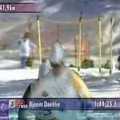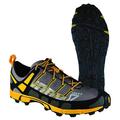Good sprints vs. bad sprints
2010.05.14. 12:45
Many of you know, that I don't really like sprint competitions. They are often boring, doesn't give you anything orienteering-wise. Also, I can be very happy, if I see or - horribile dictu - run a good sprint course. Yesterday, I was very sad, but went to bed extremely happy.
So, what makes a good sprint course for an O-geek like me?
- good terrain. Best is mixed terrain, with both forest and urban areas. Parks are not too interesting most of the time. Also the forest shouln't be neither straightforward, nor flat.
- climbing. Route-choices without climbing are often quite straightforward. 3D route-choices can be very-very interesting!
- technical difficulty. I like to say, that sprint orienteering is a combination of sprint and orienteering. For me, the latter one is more important. Also, hidden controls are a must for me.
- changes. Terrain changes, rhythm changes, etc. Forest --> urban --> forest; short --> long --> short
- lot of controls (under these circumstances). In my opinion, you should have the same number of controls for all disciplines :-)
- no compromises. If the terrain best adapts to a course, which is 18-minutes long, so be it! Don't make any compromises! I don't like compromises with the terrain either. Here in Hungary, we often hear, that what do you want from this terrain? You can't do any better here! For one thing, it's not true in most cases. As for the other part, in my opinion, you shouldn't use that specific terrain for (sprint) orienteering. It's just as simple as that.
Both the Swedish and the Norwegian Sprint Championships were held yesterday evening, in Karlstad and Levanger, respectively. Both fields were high-quality, but while the latter offered some vintage terrain and courses, while the former was pretty much average, or even below average.
I don't really want to speak about SM-Sprint. Congratulations to Helena Jansson and Emil Wingstedt, for winning their respective classes. If you are interested about the courses, you can see them here, with the GPS-tracking (which was btw. quite inaccurate in some cases):
- D21: http://www.tulospalvelu.fi/gps/20100513smsprintD/
- H21: http://www.tulospalvelu.fi/gps/20100513smsprintH/

So, SM-Sprint finished at about 18:30, and NM-Sprint started at about 19:00. When I saw the course data - 3.140/180/27 for H21 and 2.750/170/24 for D21 -, I was quite convinced, that this will be an interesting course - one, which I would be happy to run. Also, the winning times were said to be 17 minutes, which told me, that there are no compromises in this course. So the courses with GPS-tracking are here (GPS had it's ups and downs here also):
- D21: http://www.tulospalvelu.fi/gps/20100513nmsprintD/
- H21: http://www.tulospalvelu.fi/gps/20100513nmsprintH/

Generally, I must say, that I find it a very good idea, if these two courses are as similar as possible (you have to use a quarantine, of course). The NM-courses were absolutely the same from the point, they came out of the forest, which was 2/3 of the Men's course! Best time for this "last" section was 14'46" for the women and 12'31" for the men, which is a difference of 118%. It's good to know this number! :-)
The courses started with two easy urban controls, then a longer, common route-choice. I would have definitely missed this one, as I would have gone around from the right, which was just a touch slower. Then, some shorter legs in the forest, which was quite OK for sprints (the men even had a route-choice), and then the common part started.
The first big common leg ended at the top of the hill, near what seems to me like a church, so one hell of a lot of climbing had to be made. Obviously two route-choices, although a lot of guys executed the right one a bit badly. Right was faster though. The second big route-choice was down the hill. I would have gone right, for better speed and easier orienteering, and it looks as if, that was just a touch faster. It's just a shame, that there wasn't a real difference between the two route-choices. The course from here on, was a bit more straightforward, a lot of controls, uneasy vegetation, but basically you just had to run. The good thing was, that the minor placings were decided in this shorter loop.
Also the map, made by the renowned WOC-mapper Roar Valstad, just looked stunningly beautiful. I'm not a big fan of contours, automatically taken from laser-scanning, but it made sense here, while the other parts of the map just looked awesome!
Kudos to both the course-setter and mapmaker of NM-Sprint, while it's a bit of a shame for the SM-Sprint, that it showed such a big contrast to it. Better luck next time!
On a footnote, I'm also running an unconventional sprint race tomorrow, in what is best described as an open area with scattered vegetation. I don't have high hopes for the terrain, but will try to analyse the race here next week.
A bejegyzés trackback címe:
Kommentek:
A hozzászólások a vonatkozó jogszabályok értelmében felhasználói tartalomnak minősülnek, értük a szolgáltatás technikai üzemeltetője semmilyen felelősséget nem vállal, azokat nem ellenőrzi. Kifogás esetén forduljon a blog szerkesztőjéhez. Részletek a Felhasználási feltételekben és az adatvédelmi tájékoztatóban.




